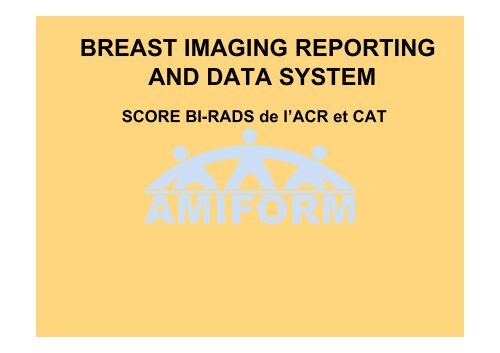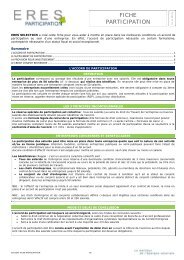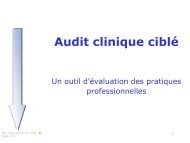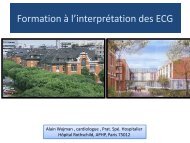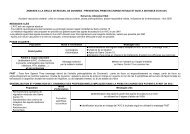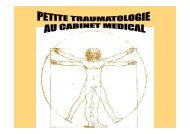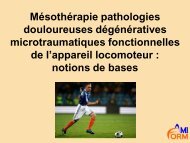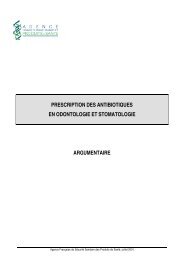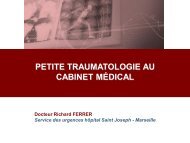Score BI-RADS de l'ACR et CAT
Score BI-RADS de l'ACR et CAT
Score BI-RADS de l'ACR et CAT
Create successful ePaper yourself
Turn your PDF publications into a flip-book with our unique Google optimized e-Paper software.
Métho<strong>de</strong> standardisée pour les CRlexique <strong>de</strong>scriptif illustré <strong>et</strong> reproductibleévaluation <strong>de</strong>s anomalies mammaires : classificationprise en charge optimale <strong>de</strong>s patientesATLAS mammographie*-échographie-IRM **classification <strong>BI</strong>-<strong>RADS</strong> <strong>de</strong> l ’ACR publiée en 2004 par la SFRrecommandée par l ’ANAES en DMO <strong>et</strong> en diagnostic (1998/2002)*2ème édition française,4ème américaine (1990)**2004 (F) <strong>et</strong> 2003 (USA)
Le <strong>BI</strong>-<strong>RADS</strong> en MAMMOGRAPHIE : LEXIQUEMASSES : 2 inci<strong>de</strong>nces différentes (asymétrie : si une inci<strong>de</strong>nce) Formeron<strong>de</strong>,ovaleirrégulièrelobulée
Contours : n<strong>et</strong>s,indistincts,flous,masquésDensitémicrolobulésspiculéshypo<strong>de</strong>nse+graisse
CALCIFI<strong>CAT</strong>IONS Macro-calcificationscalcifications > 1mm Micro-calcificationscalcifications : 200-500µ• Regroupement : foyer (5< 1cm 3 )éparses, amas lâche• Morphologie <strong>et</strong> distribution• Nombre <strong>de</strong> calcifications : si >15 VPP>50%foyers : si > 2 VPP>70%
MICRO-CALCIFI<strong>CAT</strong>IONS : AGRANDISSEMENTAnalyse séméiologique+++
Bénignes
éparses bénignesron<strong>de</strong>s <strong>et</strong>punctiformessédimentées
suspectes forte probabilité <strong>de</strong> malignité
Distribution régionalelinéairesegmentaire
ASYMÉTRIE FOCALE <strong>de</strong> <strong>de</strong>nsitéVPP=0-6%Avec <strong>et</strong> sans graisseNLE
LE <strong>BI</strong>-<strong>RADS</strong> en ECHOGRAPHIE-spécifiques à l’US : orientation, échostructure-non spécifiques : forme <strong>et</strong> contours
• Echostructure % graisse : 30% <strong>de</strong>s cancers isoéchogènesVPP la + élevée pour irrégularité <strong>de</strong> la forme <strong>et</strong> contours>90%VPN 98 à 100% pour hyperéchogénicitécontours lisses <strong>et</strong> n<strong>et</strong>s peu lobulésaxe parallèle à la peaucomplexe
• Faisceau acoustique : NS• Zone <strong>de</strong> transition• Autres signesgalactophoresCalcifications +/-masse
Cytostéatonécrose CC microinvasif Radial Scar+++ corréler les anomalies US/mammographie+++ ne pas pallier aux insuffisances techniques <strong>de</strong> lamammographie
CAS SPÉCIAUX = DIAGNOSTICS UNIQUESSiliconomeGanglion intra-mammmaireKystes compliquésDFK , métaplasie cylindrique
<strong>CAT</strong>EGORIES d’EVALUATION <strong>BI</strong>-<strong>RADS</strong> mammographique <strong>de</strong> l’ACRCatégorie 0Catégorie 1Catégorie 2Catégorie 3Catégorie 4Catégorie 5Une imagerie complémentaire ou une comparaison avec les clichésantérieurs sont nécessaires (clichés localisés, agrandissement,inci<strong>de</strong>nce radiographique particulière, échographie mais aussi IRMou biopsie) ; il s’agit d’une catégorie d’attente alors que les autressont finales.Mammographie normale, rien à décrireNormale mais présence d’anomalie bénigne (fibroadénome,hamartome, lipomes, ganglions, cicatrices, calcifications bénignes)Anomalie infraclinique, très probablement bénigne dont la VPP estinférieure à 2%, nécessitant une surveillance à court terme (massesoli<strong>de</strong>, circonscrite non calcifiée, asymétrie focale <strong>de</strong> <strong>de</strong>nsité,calcifications ron<strong>de</strong>s <strong>et</strong> punctiformes).Anomalie suspecte à biopsier. Compte tenu <strong>de</strong> la large fourch<strong>et</strong>te<strong>de</strong> la VPP (3 à 94 %), elle est divisée en 3 sous-catégories (a, b, c)Anomalie hautement suspecte <strong>de</strong> malignité (VPP ≥ 95 %) pouvantêtre opérée d’emblée mais la prise en charge oncologique peutnécessiter <strong>de</strong>s prélèvements tissulaires (ganglion sentinelle,traitement néoadjuvant).
1ACR 1 : mammographie normale2graisseuxhomogène glan<strong>de</strong> glan<strong>de</strong>75% hétérogène 51%>glan<strong>de</strong> < 75%
ACR 2
ACR 3VPP < 2%
ACR 4SUSPECT
2002ACR 51998
ACR45ACR 4 3ACR 5+ haut niveau <strong>de</strong>suspicionou aspect le +spécifique
RECOMMANDATIONSEn cas d ’anomaliesbénignes probablement bénignes suspectes malignesDépistagebiennalSurveillancerapprochée 6 moisBiopsiepercutanéePrise en chargemultidisciplinairePrendre en compte: ATCD personnels <strong>et</strong> familiauxla confrontation aux bilans antérieursla cliniqueles souhaits <strong>de</strong> la patiente
ACR 0 si problème <strong>de</strong>récidive/cicatrice2000ACR 0 si échographie suspecte1ère intention femme jeune
ACR 1 : mammographie négative+anomalie cliniqueACR 5Échographie+++ACR 3
• OPACITES ACR 3 : probablement bénignesRONDES/REGULIERESECHOGRAPHIE +++ soli<strong>de</strong>/liqui<strong>de</strong>1/4 <strong>de</strong>s opacités ron<strong>de</strong>s non palpables sont <strong>de</strong>s kystesMais 2 fois plus <strong>de</strong> cancers dans les masses que dans lesmicrocalcifications classées ACR3 Kystes simplesDiagnostic échographique # 100% ACR 2 dépistage à 2ans
Kystes échogènes : VPP = 0.2%Surveillance rapprochée : ACR 3 Si modification : aspiration, <strong>et</strong> si soli<strong>de</strong> : histologie Kystes complexes : ACR 4masses intrakystiques,nodules pariétaux0.3% <strong>de</strong> cancers +++ ne pas vi<strong>de</strong>r complètement biopsie selon cytologie ou d’emblée (vascularisation)
OPACITES ACR 3 2Nodules soli<strong>de</strong>s
• Nodules soli<strong>de</strong>s ACR 3 si critères US <strong>de</strong> bénignité & imagerie concordante + si absence <strong>de</strong> facteurs <strong>de</strong> risque : probabilité faible <strong>de</strong> cancerVPP= SIKLES 4533 anomalies suivies : 1.3% cancersVARAS > 500 1.7%(1992) 0,4%(2002)Tous les cancers diagnostiqués sont <strong>de</strong> bon pronostic surveillance échographique à 4, puis 6 mois,puis 1 an, minimum 2 ans
<strong>BI</strong>OPSIE2004 2002si anomalie palpable si modification
• Distorsions architecturales visibles sur une seuleinci<strong>de</strong>nce• Asymétries focales <strong>de</strong> <strong>de</strong>nsité concaves sans micro-calcification ni distorsion architecturale ACR3 intérêt <strong>de</strong> la VPN <strong>de</strong> l’échographie +++ACR3Surveillance mammographique
Asymétries focales <strong>de</strong> <strong>de</strong>nsité à échographie normale &surveillance. SICKLES 500 suivies /4533 p 3 K. OREL 32 biopsiées /1400 p 0. VIZCAINO 82 suivies /795 p 0US négative/inutile2000 +++ si au cours <strong>de</strong>la surveillancel ’anomalie <strong>de</strong>vientpalpable ouprogresse : <strong>BI</strong>OPSIE2002 si masse tissulaire<strong>CAT</strong> fonction <strong>de</strong>l’aspectséméiologique
• Distorsion architecturale <strong>et</strong> surcroît <strong>de</strong> <strong>de</strong>nsité à limitesconvexes : ACR4US : visualisation <strong>de</strong>s spicules dans les seins <strong>de</strong>nses cible pour les distorsions architecturales
RECOMMANDATIONSANOMALIES ACR 4kyste simple kyste échogène US normale US ACR 5DFK ou ACR 4DépistagebiennalSurveillancerapprochée6 moisBiopsiepercutanéePrise en chargemultidisciplinairePrendre en compte : ATCD personnels <strong>et</strong> familiauxla confrontation aux bilans antérieursla cliniqueles souhaits <strong>de</strong> la patiente
Recherche invasion :bilan pré-thérapeutiqueGanglion sentinelleMais problème <strong>de</strong> sousestimation<strong>de</strong>10% pour l’invasionCALCIFI<strong>CAT</strong>IONS typiquement malignes : ACR 5MACRO-<strong>BI</strong>OPSIES OU <strong>BI</strong>OPSIE CHIRURGICALE
Si malignité certaine <strong>et</strong> foyers étendus : CHIRURGIE MICRO-<strong>BI</strong>OPSIEsi opacité associéesous échographieou stéréotaxie Si patiente à risque : ACR 3calcifications suspectes ou indéterminées : ACR 4MACRO-<strong>BI</strong>OPSIES stéréotaxiquesEviter chirurgie pour lésions bénignesDiagnostic <strong>de</strong>s lésions à risque
US souvent inutileétiologieextensionACR 5CCIS haut gra<strong>de</strong>
RECOMMANDATIONSMICRO-CALCIFI<strong>CAT</strong>IONSACR 2 ACR 3 ACR 4 ACR 5FDRDépistagebiennalSurveillancerapprochée 6 moisMacro-biopsiepercutanéeBiopsiechirurgicalePrendre en compte: ATCD personnels <strong>et</strong> familiauxla confrontation aux bilans antérieursla cliniqueles souhaits <strong>de</strong> la patiente
ACR 3 Compliance <strong>de</strong>s patientes 89% (VARAS) Respect <strong>de</strong>s recommandations par 90% <strong>de</strong>s radiologuesTaux <strong>de</strong> cancers dans ACR 3 élevé dans les séries <strong>de</strong> macrobiopsies Variation inter-observateurs > autres catégories• Difficulté d’analyse• Imagerie non spécifiqueformation <strong>de</strong>s radiologues+++évaluation ACR 4 : 3 catégories


